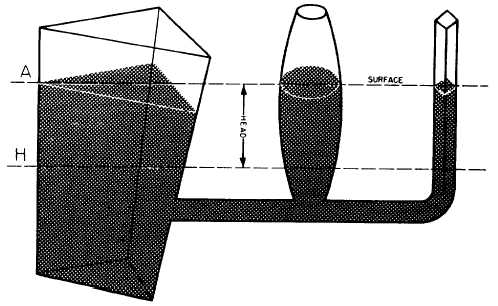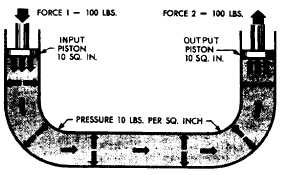Since pressure is equal to the force per unit area,
set A equal to 1. Then the formula pressure
becomes
P = h D
Equation 2-5.
It is essential that h and D be expressed in similar
units. That is, if D is expressed in pounds per
cubic foot, the value of h must be expressed in
feet. If the desired pressure is to be expressed in
pounds per square inch, the pressure formula,
equation 2-5, becomes
Equation 2-6.
Pascal was also the first to prove by
experiment that the shape and volume of a
container in no way alters pressure. Thus in figure
2-8, if the pressure due to the weight of the liquid
at a point on horizontal line H is 8 psi, the
pressure is 8 psi everywhere at level H in the
system. Equation 2-5 also shows that the pressure
is independent of the shape and volume of a
container.
Pressure and Force in Fluid Power Systems
Figure 2-9.—Force transmitted through fluid.
of the shape of the container. Consider the effect
of this in the system shown in figure 2-9. If there
is a resistance on the output piston and the input
piston is pushed downward, a pressure is created
through the fluid, which acts equally at right
angles to surfaces in all parts of the container.
If force 1 is 100 pounds and the area of the
input piston is 10 square inches, then the pressure
in the fluid is 10 psi
Recall that, according to Pascal’s law, any
force applied to a confined fluid is transmitted
in all directions throughout the fluid regardless
NOTE: Fluid pressure cannot be created
without resistance to flow. In this case, resistance
Figure 2-8.—Pressure relationship
2-6
with shape.




